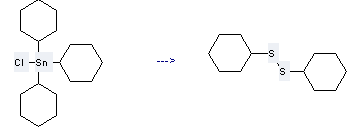-
Name
TRICYCLOHEXYLTIN CHLORIDE
- EINECS 221-437-5
- CAS No. 3091-32-5
- Article Data18
- CAS DataBase
- Density
- Solubility Soluble in ethanol, ether, toluene and chloroform. Insoluble in water.
- Melting Point 123-125 °C(lit.)
- Formula C18H33ClSn
- Boiling Point 408.8 °C at 760 mmHg
- Molecular Weight 403.623
- Flash Point 201.1 °C
- Transport Information
- Appearance
- Safety 26-28-61-60
- Risk Codes 20/21/22-50/53
-
Molecular Structure
-
Hazard Symbols
 Xn,
Xn, N
N
- Synonyms Tin,chlorotricyclohexyl- (7CI);Tricyclohexyltin chloride (6CI);Chlorotricyclohexylstannane;Chlorotricyclohexyltin;NSC 202692;Tricyclohexylstannyl chloride;Tris(cyclohexyl)tin chloride;
- PSA 0.00000
- LogP 7.17360
Stannane,chlorotricyclohexyl- Specification
The Stannane,chlorotricyclohexyl-, with the CAS registry number 3091-32-5, is also known as Chlorotricyclohexylstannane. Its EINECS registry number is 221-437-5. This chemical's molecular formula is C18H33ClSn and molecular weight is 403.62. Its IUPAC name is called chloro(tricyclohexyl)stannane.
Physical properties of Stannane,chlorotricyclohexyl-: (1)ACD/LogP: 5.25; (2)# of Rule of 5 Violations: 1; (3)ACD/LogD (pH 5.5): 5.25; (4)ACD/LogD (pH 7.4): 5.25; (5)ACD/BCF (pH 5.5): 5768.27; (6)ACD/BCF (pH 7.4): 5768.27; (7)ACD/KOC (pH 5.5): 17129.63; (8)ACD/KOC (pH 7.4): 17129.63; (9)#Freely Rotating Bonds: 3; (10)Flash Point: 201.1 °C; (11)Enthalpy of Vaporization: 63.52 kJ/mol; (12)Boiling Point: 408.8 °C at 760 mmHg; (13)Vapour Pressure: 1.61E-06 mmHg at 25°C.
Uses of Stannane,chlorotricyclohexyl-: it can be used to produce dicyclohexyl disulfide at temperature of 150 °C. This reaction will need reagents S8, KF and solvent dimethylformamide, H2O with reaction time of 22 hours. The yield is about 50%.

When you are using this chemical, please be cautious about it as the following:
This chemical may cause damage to health. It also may present an immediate or delayed danger to one or more components of the environment. In addition, it is harmful by inhalation, in contact with skin and if swallowed. Hence, this chemical is very toxic to aquatic organisms which may cause long-term adverse effects in the aquatic environment. In case of contact with eyes, you should rinse immediately with plenty of water and seek medical advice. After contact with skin, please wash immediately with plenty of ... (to be specified by the manufacturer).
You can still convert the following datas into molecular structure:
(1)Canonical SMILES: C1CCC(CC1)[Sn](C2CCCCC2)(C3CCCCC3)Cl
(2)InChI: InChI=1S/3C6H11.ClH.Sn/c3*1-2-4-6-5-3-1;;/h3*1H,2-6H2;1H;/q;;;;+1/p-1
(3)InChIKey: OJVZYIKTLISAIH-UHFFFAOYSA-M
Related Products
- Stannane, butylchloro-
- Stannane, dibutylbis[(1-oxo-9-octadecenyl)oxy]-
- Stannane, dibutyldipentanoyloxy-
- Stannane, dibutyldipropionyloxy-
- Stannane, didodecyl-,1-oxide
- Stannane, diethylbis(octanoyloxy)-
- Stannane, diethyldimethyl-
- Stannane, hydroxyoctyloxo-
- Stannane, tetradodecyl-
- Stannane, tetrafluoro-(9CI)
- 30918-54-8
- 3092-17-9
- 30922-25-9
- 309245-24-7
- 30924-93-7
- 30925-07-6
- 30925-11-2
- 30925-18-9
- 309263-13-6
- 309263-22-7
Hot Products
About|Contact|Cas|Product Name|Molecular|Country|Encyclopedia
Message|New Cas|MSDS|Service|Advertisement|CAS DataBase|Article Data|Manufacturers | Chemical Catalog
©2008 LookChem.com,License: ICP
NO.:Zhejiang16009103
complaints:service@lookchem.com Desktop View